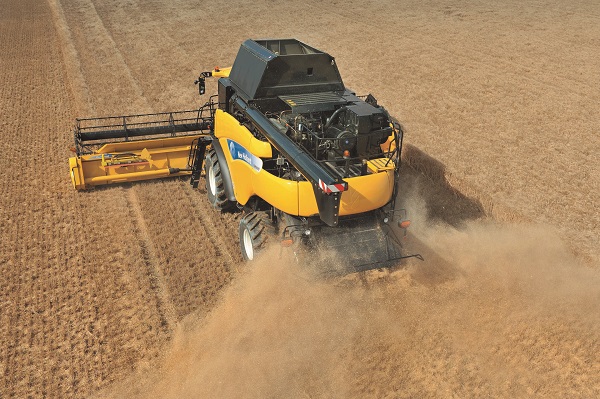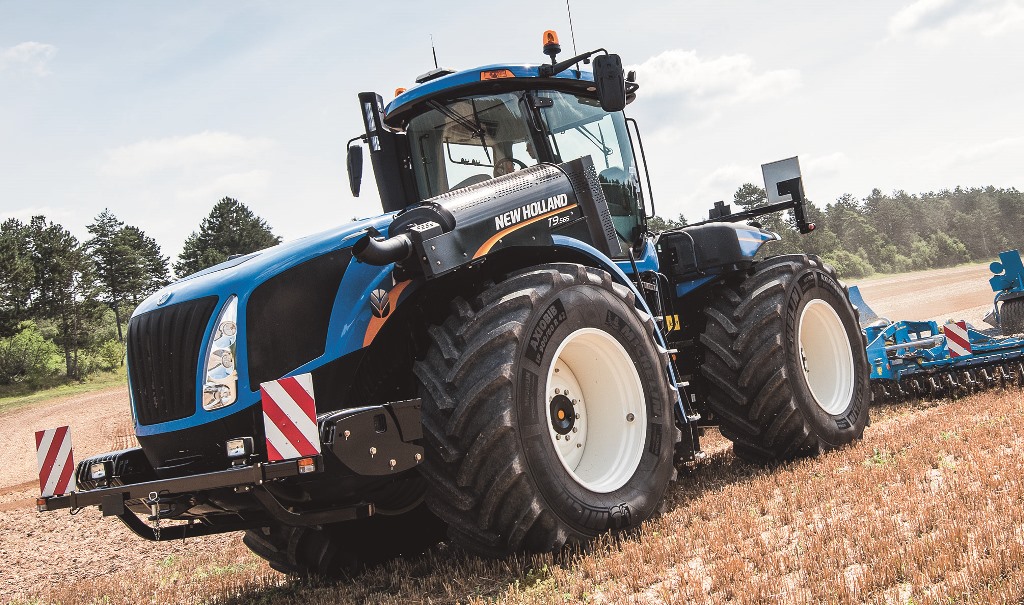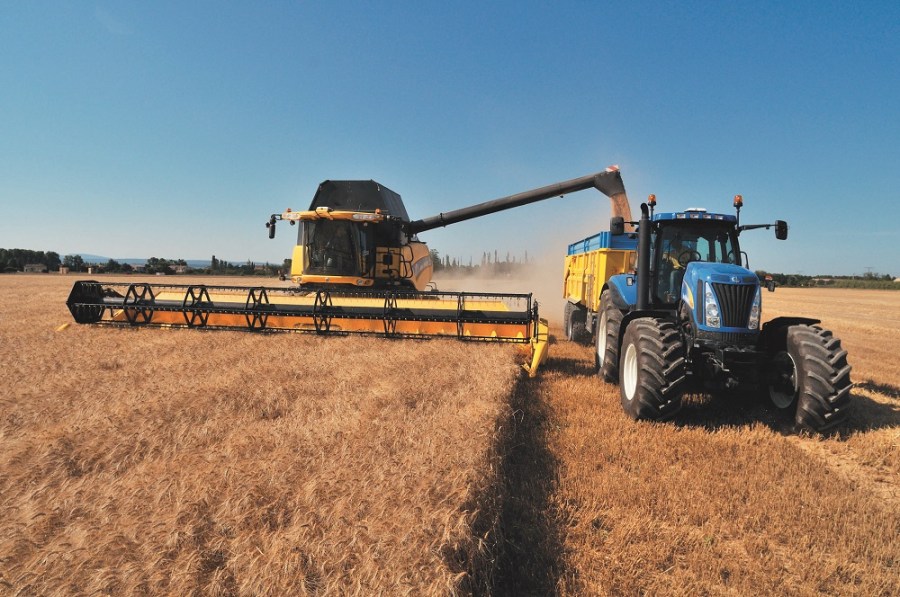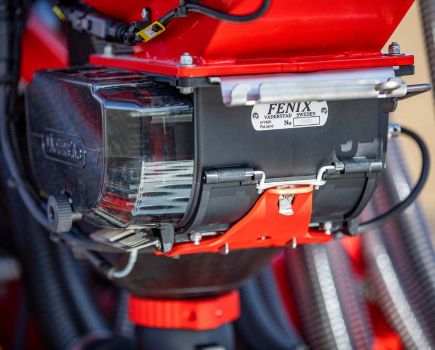When an Oxon estate came to renew its combine, there was no hesitation over staying loyal to New Holland. CPM went to find out how the new CR 9.90 rotary machine has performed so far.
The larger grain tank is a noticeable improvement.
By David Jones
The public face of the Wills Estate for many living in its environs or passing through it involves racehorses. Lots of them. Some being exercised on the gallops, others grazing in paddocks.
The estate, which straddles the Northants/Oxon border north of Banbury, is home to four established racing stables that between them have the careers of around 200 of the elegant creatures in their hands. Beyond these lies the farming business – close to 900ha of arable land run for the past 10 years by estate manager Hamish Gairdner.

New Holland is staking a claim for highest output ever for its new CR combines.
Last year, the estate renewed its combine. “We were running a NH 9080 on tracks, with a 9.1m vari-feed header,” he explains. “Prior to that, we’d had another 9080, but on tyres, again with a 9.1m header.
“We try to change the combine after three seasons, but we buy them with an extended, four-year warranty and a service contract so we always know our operating costs up front. It means we can also sell on the combine with a full year’s warranty remaining, which gives us a better overall return on the investment.
“The decision to go for the NH 9.90 was influenced mainly by its increased productivity and the larger grain tank. It was also a stock machine at the dealership, so we were able to haggle on the price a little more.”
When asked to highlight the most noticeable differences between the 9.90 and its immediate predecessor, Hamish is clear in his response. “Starting at the front end, the header follows the ground better than the previous version,” he states. “The new 10.7m version has three height sensors, so on our undulating land, we’re not making contact with the ground to the extent that we were before.
“The stone trap is improved and the crop flow much enhanced, thanks to the DFR (Dynamic Feed Roll), over the previous 9080. The larger grain tank is a noticeable improvement – we only take one full tank while unloading on the move and head back to the store with 14t on board. And the Opti-Spreader on the back is a vast improvement over the previous machine, width a full width spread being achieved.”
DFR is a feature that’s available on all of New Holland’s new CR model combines, designed to improve the performance of the rotors. It’s effectively a beater that helps to transfer the crop mat from the feeder house to the rotors more efficiently.
The system also plays a significant part in in the removal of stones from the crop flow without the requirement of having to stop the machine and close a stone trap. In fact, NH says that protection from stones is what its engineers were aiming to achieve when designing the DFR, but they found that it made a significant difference to the combine’s overall performance.
However, if he could change any aspect of the new 9.90, Hamish has just the one suggestion to make: “The unloading auger needs to be either longer or shorter,” he says. “This would save us having to drive on the cut swath. The compromise we adopted during its first season here was to unload with the unloading auger only three-quarters out, so that the trailers run on the near side of the swath.”
The machine’s primary combine operator has been employed on the estate for 40 years, and has noticed improvements in the latest cab environment, continues Hamish. “He appreciates the quieter operating platform and the big improvement that’s been made to the lighting. He also feels that the DFR makes the whole machine run a lot more smoothly.”
The switch to tracks in place of wheels at Wills Estates was made with the 9.90’s predecessor, the second NH 9080. “We found with the wheeled version that it would hop up the hill banks which, in turn, meant that the header was unable to maintain a constant cutting height,” he recalls. “This resulted in poor crop feed up the trunking.
“After we traded that machine in for the tracked model, we saw an increase of between 2-3% in productivity, together with reduced soil compaction. It also performed considerably better on slopes and undulating ground.”
Yield mapping has become a routine operation on the estate, with data collated since 2008. Telematics aren’t employed, however. “As we operate within a ring-fenced area, we’re never more than 10 mins away from any machine,” Hamish explains.
In addition to his satisfaction with the latest combine, he’s pleased with the service he receives from the nearest New Holland dealership – the Turney Group. “We’ve a good trading relationship with them and have one of their technicians assigned to the combine who attends to any issues that might arise during the season,” he says.
“There are times when our regular technician is unable to get to us for some reason, but we’ve always had one with us within an hour of the call.” In the case of the 9.90, its first season’s work was devoid of problems – even of the teething variety – so no requests for assistance have yet been made on its behalf.
The wide range of soil types presents its own challenges to crop production here. “The top of the estate has lighter soils over iron stone,” Hamish explains, “with some fields only having 200mm of soil over rock. Towards the river (Cherwell) we have some heavier ground with a higher clay content. No two fields are the same and most of them have a range of soil types within them.” One of them, with 12 different soil types, has been taken out of production and put into the Mid-Tier Countryside Stewardship scheme.
“Every farm has its own challenges and our main ones are field size and topography,” he adds. “Across the estate, the land ranges between 100m and 180m above sea level.”
These are natural obstacles, of course, but a subject of more immediate concern at Wills Estates is the impending impact of the new HS2 high speed rail line. The line is due to cut through the northern end of the estate, severing some fields and cutting off access as a result of road closures. “With enabling works planned to begin very soon,” Hamish states, “we’ve started with mitigation planning relating to the issues, but it’s still a big unknown.”
Farm Facts
Wills Estates, Edgcote, Banbury, Oxon
- Cropped area: 891ha
- Soil types: shallow ironstone to heavy clay
- Current rotation: winter wheat (70% milling, 30% feed), winter oilseed rape (HEAR), spring barley
- Combine: New Holland CR 9.90 Rotary with 10.7 header
- Mainline tractors: NH T5.105, T7070, T7.270, NH T8.390
- Loader: Merlot T50.8
- Cultivation: 4m Väderstad TopDown
- Drill: 4m Väderstad Rapid
- Sprayer: Amazone UX 5200 with 36m boom
T9 AutoCommand makes its UK debut
 The Wills Estate was also NewHolland’s chosen venue for the recent UK launch of its high horsepower, articulated T9 AutoCommand – a tractor billed as having the largest power unit in the agricultural sector to incorporate Continuously Variable Transmission (CVT). Introduced to the market towards the end of last year, the first unit to appear in this country was a 647hp T9.645.
The Wills Estate was also NewHolland’s chosen venue for the recent UK launch of its high horsepower, articulated T9 AutoCommand – a tractor billed as having the largest power unit in the agricultural sector to incorporate Continuously Variable Transmission (CVT). Introduced to the market towards the end of last year, the first unit to appear in this country was a 647hp T9.645.
Over two days, the new powerhouse machine was unveiled to the UK farming press and then to more than 40 dealership personnel, who were taken through a series of training sessions with NH specialists.
The AutoCommand ZF element relates to the machine’s transmission management system, in which the engine rpm reduces automatically to the minimum required to carry out the task in hand. Peak power is available in every forward speed, while continuous power, evenly delivered, is available at speeds ranging from 500 metres/hr up to 43km/h. Travelling at the maximum speed, the engine is turning over at a mere 1600rpm.
New Holland is keen to highlight AutoCommand’s Active StopStart safety feature – understandable given the tractor’s weight and draught capabilities. This comes into operation when the tractor comes to a halt on an incline and prevents further movement forwards or back.
An automatic process, StopStart is claimed to be equally effective when there’s a heavy load involved. In the case of the T9, this can be substantial, so the feature is likely to reassure operators when working on steeper ground.
Additional features include the ability to add or remove up to 5.5t of additional ballast, together with a level of manoeuvrability that allows a turning circle of 10.7m. Even when fitted with 900/60R42 tyres the vehicle’s width remains below 3m. In fact, the T9 comes in two chassis sizes – the slimline engine hood 900mm standard and the broad acre 1100mm option.
The manufacturer is placing good deal of emphasis on the T9’s cab and the level of operator comfort and ease of function control. Each corner of the cab is suspended on spring and damper units which work in unison with an advanced anti-sway mechanism for a smooth and stable ride. Full roll-over protection is provided by captive pin mounts.
The cab designers have also borne in mind that these machines are likely to be working with some sizeable implements behind them. One of the results is a seat that will swivel 40 degrees, with the SideWinder II armrest moving with it.
New Holland is also pointing the attention of potential customers towards the articulated Tri-Point chassis. Engineered in such a way as to reduce maintenance, the design evenly transfers the machine’s weight between the front and rear axles. The principal effect of this is to lower the overall amount of ballast required, meaning that soil compaction is usefully reduced.
New Holland high horsepower marketing specialist Tim Lowden believes the T9 AutoCommand range is tailor-made for farmers looking for peaks of efficiency, performance and versatility. “The ability to utilise full power at speeds as low as 500metres/hr – or in PTO applications – brings possibilities that were previously not possible in this power class,” he states.




